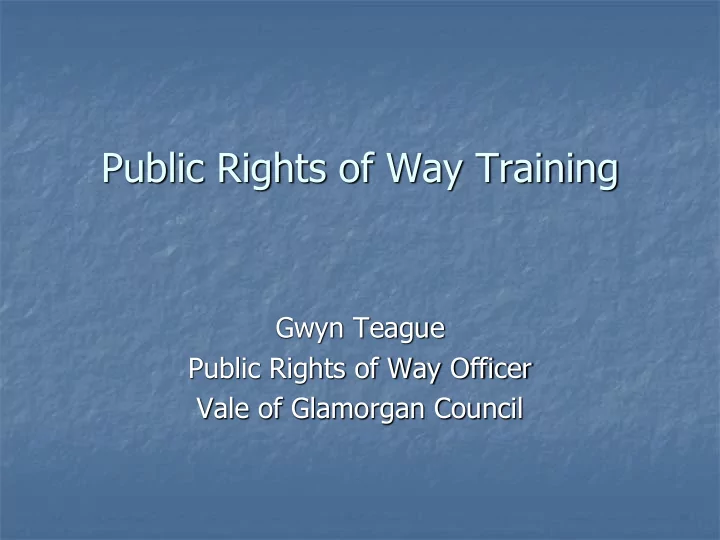

Public Rights of Way Training Gwyn Teague Public Rights of Way Officer Vale of Glamorgan Council
Definitive Map and Statement Highways recorded on the map are exclusively Footpaths Bridleways Restricted Byways Byways open to all traffic Map legally conclusive of the existence and location of rights. Statement conclusive of position, width, limitations and conditions Not conclusive of what isn’t contained
Changing the Network Creation, diversion or extinguishment of PROW requires legal mechanism. Town and Country Planning Act 1990 (TCPA1990) Highways Act 1980 (HA1980) Diversion Extinguishment Creation Order Creation Agreement Other Legal Instruments Side Road Orders Acts
Public Path Diversion Orders (TCPA s257) Applicability: Footpaths, bridleways, restricted byways. Create, Extinguish, Divert Necessary to do so in order to enable development to be carried out Cannot make order until planning permission has been awarded Cannot confirm order if development has been completed
Public Path Diversion Orders (HA1980 s119) Applicability: Footpaths, Bridleways, Restricted byways. Diversion of paths must be expedient in the interests of the landowner or the public. Diversion must not alter point of termination of the path If that point is not on a highway Where it is on a highway, to another point which is on the same highway or, another one connected with it, and which is substantially as convenient to the public.
Public Path Diversion Orders (HA1980 s119) The diversion is subject to certain legal tests before it can be confirmed Termination point and expediency in the interest of the public/landowner Diverted path will not be substantially less convenient to the public. Expediency having regard to the effect it would have on: Public enjoyment of the path or way as a whole. Other land served by the existing public right of way, taking into account provisions for compensation. The new path or way on the land over which it is to be created and any land held with it, taking into account provisions for compensation. Any material provisions included within the Rights of Way Improvement Plan for the area.
Public Path Extinguishment Orders (HA1980 s118) Applicability: Footpaths, Bridleways, Restricted byways. Extinguishment of path where it is not needed for public use having regard to: The extent to which that the path or way would, apart from the Order, be likely to be used by the public. The effect on land served by the path or way, account being taken of the provisions as to compensation. Section 118(6), which allows for temporary circumstances preventing the use of the way being disregarded. May be made concurrently with creation orders
Public Path Creation Orders (HA1980 s26) Applicability: Footpaths, Bridleways, Restricted byways. Creation of path where one is needed and it is expedient to do so having regard to: The convenience or enjoyment of a substantial section of the public; or The convenience of persons resident in the area. Other consideration include: Rights of persons interested in the land Compensation Agriculture, forestry and conservation May be made concurrently with extinguishment orders
Public Path Creation Agreements (HA1980 s25) Applicability: Footpaths, Bridleways, Restricted byways. Requires owner to demonstrate capacity May provide for Compensation Works Conditions compatible with a PROW May not be taken into account alongside extinguishment unless already in force
Magistrates Court Applications (HA1980 s116) Applicability: Footpaths, bridleways, restricted byways, byways open to all traffic. Extinguish, Divert Authority should have good reasons for not making use of other powers Scheme includes vehicular rights Extinguish vehicular rights subject to retention of lower status route
Recommend
More recommend